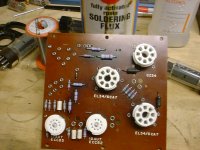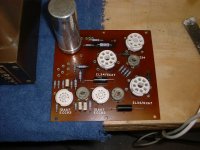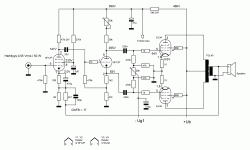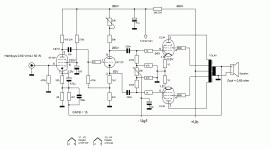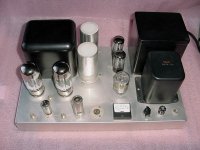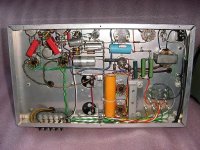Hi Folks,
Long message, this one. In a bit of a quandary and I am looking for some wisdom from the group here.
There are so many amplifiers out there, new, vintage, DIY, solid state, vacuum tube, Chip Amps Class D and on and on.
I happen to have a pair of Acrosound ULII that I restored about 10 years ago. They were complete and in good mechanical and cosmetic shape. I pulled the boards, cleaned them up and replaced all the parts with new modern parts. All the power supply caps were replaced. The only original parts left are the 3 board mounted potentiometers.
Along the way I decided that I did not like the printed circuit board mounted output tubes, but worse, those EL-34’s are running at a B+ greater than the tube is spec’d at. At least that’s my understanding. And 60 watts out of a pair of EL-34’s? Yikes, can that be for real?
In spite of all that, I have always heard that the output transformers are second to none including modern transformers. Whether this is true or not is subject of grand speculation I’d imagine. But while I do hear great things about the transformers, I rarely hear any praise for the ULII amplifier itself. Why is that?
So here I am, now trying to get back into the hobby. I have these amps (and others) but I don’t at this moment, have a pair of speakers to listen to anything on. So I cannot do any comparisons. That’s because the Magnepan SMG-a’s I had, have been gone quite a while. No room at the time.
Ideally, I’m trying to get down to one system and don’t want to play the “amp of the week” game. That means I need to make a decision about whether these Acrosounds are contenders and as such, should they stay or go. This may have to happen even before I buy new speakers. I’m thinking along the lines of KEF LS50 or similar stand mounted speaker.
So what's the deal? I know the amps and the transformers are legendary, But is that due to their provenance, meaning David Keroes, David Hafler, mid 1950’s golden age of audio and the Ultralinear Circuit design etc. Or are these amps truly great sounding amplifiers by virtually any standard?
Thank you for your thoughts and input on this interesting amplifier.
Curt
P.S. Other amps include, of all things, a pair of Kenwood L-07M’s,
a Heathkit AA-30 (EL-84 PP), a few DIY Single Ended amps in various states of disrepair (45, 2A3, 300B), a Bryston 2B-LP
and a DIY 25 watt OTL amp that likes to smoke every once in a while. Oh and lots of boards and parts mostly related to PASS DIY amps,
but none completed nor likely to be completed in my lifetime. I just want to listen to the music
What the heck, a few pics of the amps in question
Long message, this one. In a bit of a quandary and I am looking for some wisdom from the group here.
There are so many amplifiers out there, new, vintage, DIY, solid state, vacuum tube, Chip Amps Class D and on and on.
I happen to have a pair of Acrosound ULII that I restored about 10 years ago. They were complete and in good mechanical and cosmetic shape. I pulled the boards, cleaned them up and replaced all the parts with new modern parts. All the power supply caps were replaced. The only original parts left are the 3 board mounted potentiometers.
Along the way I decided that I did not like the printed circuit board mounted output tubes, but worse, those EL-34’s are running at a B+ greater than the tube is spec’d at. At least that’s my understanding. And 60 watts out of a pair of EL-34’s? Yikes, can that be for real?
In spite of all that, I have always heard that the output transformers are second to none including modern transformers. Whether this is true or not is subject of grand speculation I’d imagine. But while I do hear great things about the transformers, I rarely hear any praise for the ULII amplifier itself. Why is that?
So here I am, now trying to get back into the hobby. I have these amps (and others) but I don’t at this moment, have a pair of speakers to listen to anything on. So I cannot do any comparisons. That’s because the Magnepan SMG-a’s I had, have been gone quite a while. No room at the time.
Ideally, I’m trying to get down to one system and don’t want to play the “amp of the week” game. That means I need to make a decision about whether these Acrosounds are contenders and as such, should they stay or go. This may have to happen even before I buy new speakers. I’m thinking along the lines of KEF LS50 or similar stand mounted speaker.
So what's the deal? I know the amps and the transformers are legendary, But is that due to their provenance, meaning David Keroes, David Hafler, mid 1950’s golden age of audio and the Ultralinear Circuit design etc. Or are these amps truly great sounding amplifiers by virtually any standard?
Thank you for your thoughts and input on this interesting amplifier.
Curt
P.S. Other amps include, of all things, a pair of Kenwood L-07M’s,
a Heathkit AA-30 (EL-84 PP), a few DIY Single Ended amps in various states of disrepair (45, 2A3, 300B), a Bryston 2B-LP
and a DIY 25 watt OTL amp that likes to smoke every once in a while. Oh and lots of boards and parts mostly related to PASS DIY amps,
but none completed nor likely to be completed in my lifetime. I just want to listen to the music
What the heck, a few pics of the amps in question
Attachments
...those EL-34’s are running at a B+ greater than the tube is spec’d at. At least that’s my understanding. And 60 watts out of a pair of EL-34’s? Yikes...
EL34 is rated 800V... are you really running more??
The big Marshall guitar amps rate 50W/pair but have been tested to 70W/pair at not-high THD (5%-10%).
The Ampeg VT-40, some versions, ran EL34 at 590V and made an honest 60W without NFB. (If you had to play hard all night every night, 6550 was a dealer option.)
And 60 watts out of a pair of EL-34’s? Yikes, can that be for real?
This gives 72 W out with 4k OPT and 460 V +Ub.
Attachments
In my opinion the Acrosound UL-II is an excellent amplifier. The design is simple and well balanced along with an innovative output transformer, the TO-600. This transformer uses a separate winding of copper ribbon tape for feedback which claims to eliminate most loading effects as well an improvement in overall performance. It's designer, Herbert Keroes, published an interesting article in the September 1958 issue of Audio Magazine about the design.So what's the deal? I know the amps and the transformers are legendary, But is that due to their provenance, meaning David Keroes, David Hafler, mid 1950’s golden age of audio and the Ultralinear Circuit design etc. Or are these amps truly great sounding amplifiers by virtually any standard?
Thank you for your thoughts and input on this interesting amplifier.
Back in the early eighties vintage tube amplifiers were easier to find at flea markets and newspaper ads then today. And they were a lot less money too. That's when I found several and decided to rebuild a pair on my own chassis. Actually all I did use was the OPT. The basic circuit was retained (almost) coupled with a stronger power supply. Then at some point I wanted to try full pentode operation with regulated screens. That's what the 6LR8 is for. But latter on I went back to partial triode (UL) because I felt the grass was greener in the middle. Now the preamp and driver stages still have the regulation even though they really don't need it.
Attachments
The major concern with these amplifiers in my recollection was heat, ventilation is critical, those boards look like the amplifier was well cared for and adequately ventilated. You've replaced the sockets which often become intermittent and all of the passives in a manner that looks careful, and highly professional.
The pots are often an area of difficulty again usually because of the way the amps are stored or allowed to run excessively warm.
The design is good, performance to a significant extent is influenced by the quality of the passive components used.
I didn't find them the last word in resolution or anything else, but for the time certainly represented the better end of the spectrum and even today you'd have to spend quite a lot to better them.
The LS50 has an impedance minima of 3.2 ohms, depending on where that occurs it might be a bit of an issue, it's also not very efficient and will require a sub woofer.. They have not provided a graph of impedance over frequency, perhaps Stereophile reviewed it at some point and has published a graph. (Otherwise it seems like a great choice - I have a friend who swears his are the best thing since sliced bread)
I guess I would try them and see..
The pots are often an area of difficulty again usually because of the way the amps are stored or allowed to run excessively warm.
The design is good, performance to a significant extent is influenced by the quality of the passive components used.
I didn't find them the last word in resolution or anything else, but for the time certainly represented the better end of the spectrum and even today you'd have to spend quite a lot to better them.
The LS50 has an impedance minima of 3.2 ohms, depending on where that occurs it might be a bit of an issue, it's also not very efficient and will require a sub woofer.. They have not provided a graph of impedance over frequency, perhaps Stereophile reviewed it at some point and has published a graph. (Otherwise it seems like a great choice - I have a friend who swears his are the best thing since sliced bread)
I guess I would try them and see..
They have not provided a graph of impedance over frequency, perhaps Stereophile
reviewed it at some point and has published a graph. (Otherwise it seems like
a great choice - I have a friend who swears his are the best thing since sliced bread)
Mine work well with a 40W tube amp, but the bass is their weak point.
KEF LS50 Anniversary Model loudspeaker Measurements | Stereophile.com
Mullard Datasheet for EL34 says 100W, one pair, class B, pentode connection.
Yes; working AT ab-Max plate voltage. Which is borderline already (800V on an Octal socket, steady? 1500V peaks?) The only way that would be professionally acceptable is if the system already had a Regulated 800V supply. Some big transmitters did run to such frills. (The 800V might also be screens in the next stage of the chain... yes, 2xEL34 as mere drivers for a 4,000 Watt B2 stage.)
The 500V-600V 50W-60W-70W condidtions do beat on the cathode current, but are not likely to Arc-And-Burn like a 800B amp.
- Status
- Not open for further replies.
- Home
- Amplifiers
- Tubes / Valves
- Thoughts and opinions on the Acrosound UL-II amplifier

